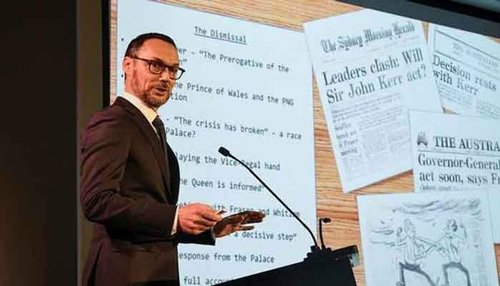Sydney
Queen Elizabeth II was not informed in advance about the 1975 dismissal of Australia’s prime minister by her representative in the country, letters kept secret for decades and released Tuesday revealed.
The British monarch’s representative in Australia, governor-general John Kerr, sparked a constitutional crisis when he fired Gough Whitlam, the democratically elected leader of the centre-left Labor party.
In May the High Court ruled more than 200 letters between the queen’s private secretary and Kerr — including many addressing the controversial affair — should be made public.
Although the correspondence shows the queen was not told immediately prior to Whitlam’s sacking, it confirms Kerr had exchanged extensive letters with the palace for months about his powers to oust the prime minister.
The queen, who is Australia’s head of state, is supposed to stay above politics and make no decisions about government appointments.
Suspicion the palace played a direct role in Whitlam’s ouster has long been cited by Australian Republicans arguing the country should break with the monarchy.
Historians are now combing through 1,200 pages of the so-called Palace Letters to see if the UK government tried to influence events in its former colony and what role the queen, her son and heir Prince Charles, and top royal advisers may have played.
One extract shows Kerr informed the queen he had fired Whitlam shortly after taking the action on November 11, 1975.
“I should say I decided to take the step I took without informing the Palace in advance because, under the Constitution, the responsibility is mine, and I was of the opinion it was better for Her Majesty not to know in advance, though it is of course my duty to tell her immediately,” he wrote.
The decision capped a protracted political stalemate after the opposition-controlled Senate refused to pass the government’s budget, severely weakening Whitlam’s position.
The letters confirm the palace knew Kerr had been considering the options available to him under his constitutional “reserve powers”, which included dismissing Australia’s leader — an action no other governor-general has taken before or since.
“I’m also keeping my mind open as to the constitutional issues,” Kerr wrote to Martin Charteris, the queen’s private secretary, on September 12, 1975.
“If the Prime Minister and the Leader of the Opposition get into a battle in which the Senate has defeated the budget, the Prime Minister refuses to recommend a dissolution, my role will need some careful thought,” he wrote.
Charteris later praised Kerr for his approach, writing a week before the dismissal he was “playing the vice-regal hand with skill and wisdom”.
“The fact you have powers is recognised. But it’s also clear you will only use them in the last resort, and then only for constitutional — and not for political — reasons,” he said.—AFP










